Verdict
Cheap, small, lightweight and easy to launch anywhere, this is a DJI drone for the masses that’s great for creating quick clips to share on social media. Those serious about aerial imaging or looking to create professional-looking vlogs will quickly find themselves frustrated at its shortcomings, but DJI has plenty of other models for those more demanding users. The Neo does what it’s designed to and does it pretty well.
Pros
- Very accessible price
- Ultra-portable size and weight
- Usable without a controller
Cons
- No object detection limits indoor use
- Average image quality
-
Multiple ways to controlChoose between controller, smartphone, DJI Goggles 3 or controller-free flight -
Designed for palm launch and landingDownward-facing sensors make take-off and touchdown in tight spots easy -
1/2-inch image sensorElectronically stabilised camera supports 4K/30p video and 12MP still photos
Introduction
DJI rules the consumer camera drone market but it certainly isn’t known for making ‘cheap’ options. Its models may represent value for money but you’ll still need to pay larger amounts for something in its smallest DJI Mini line. Not anymore: the DJI Neo is a new entry-level addition to the company’s range that’s both cheap and ultra-compact.
In fact, it’s the lightest and most compact drone DJI has ever made and is designed to work without a remote control. The thrust is not only is this thing cheap but it’s also convenient to take everywhere and launch at a moment’s notice, all without the fussing and faffing about of pairing a controller.
That’s not to say you can’t use a controller for longer and more challenging flights. Also, despite the fact it’s breaking new ground, the Neo feels very similar to existing, much pricier DJI models in some ways.
So, is the DJI Neo a cheap toy, a drone built for serious work – or something in between?
Price
DJI has launched the Neo in two different packages.
You can purchase just the drone itself and a single battery for £169/€199/$199. Alternatively, you can buy the Fly More Combo (which includes three batteries, a charging hub and an RC-N3 controller) for £299/€349.
This is a very cheap price by DJI standards. The Mavic Mini is the company’s next-cheapest drone and, despite being released back in 2019, it still costs £299 when bought as a Fly More Combo. In other words, the Neo truly does seem like DJI’s most budget-friendly option right now.
Design and Build Quality
- 135g plastic body
- Built-in propeller guards
- USB-C connectivity
The Neo is very small at 104.2 x 150 x 45.2mm and extremely lightweight at 135g. The weight means it falls into the category of drone that can be flown in public places within 50 metres of people and above people under UK law. This is all well and good, considering its intended purpose as a drone that can quickly capture shots of parties, day trips and the like.
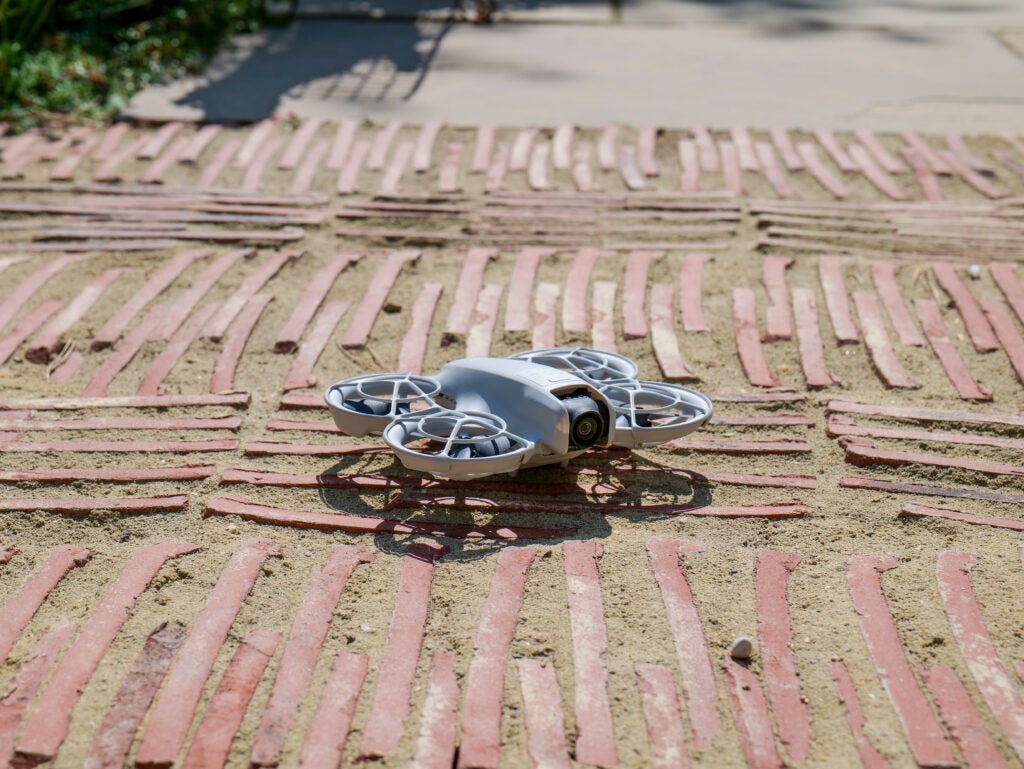

The weight also means it’s highly portable. Thanks to the sturdy plastic body, included clip-on camera cover and built-in propeller guards, it can be slung into a small bag or backpack without worrying about it getting damaged by other items. This really is a drone you can take everywhere just in case you might fancy taking an aerial photo or video. However, it’s not the most pocketable of DJI’s drones due to its non-folding design. I think you’d be able to slip a folded DJI Mini model into most jackets, but the Neo required a bit more width than the average pocket.
The Neo features only two buttons: one for power and one to cycle through what DJI calls the Intelligent Shooting Modes, each of which is represented by an icon on the drone’s top surface. I’ll go into more detail on those later in this review.
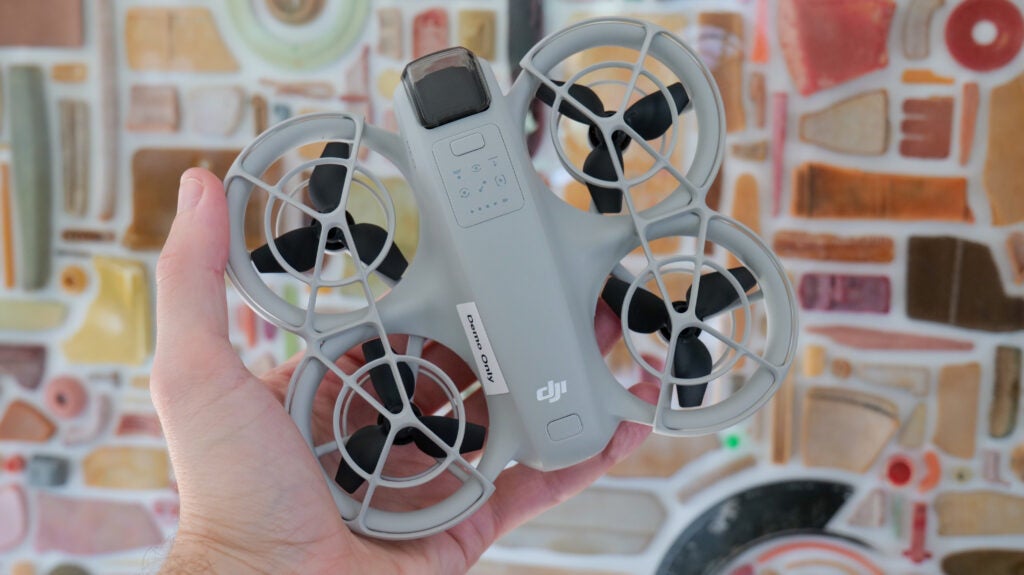

The batteries quickly slide out when required and can be charged inside the camera by connecting a USB cable to the drone’s USB-C port (a USB-C to USB-C cable is included in the box). There’s no card slot on the drone. Instead, it comes with 22GB of storage built-in.
For those who purchase the Fly More Combo, the included battery charging cradle is made of the same hard plastic as the drone and can accommodate three batteries at once, charging them all simultaneously. The remote controller, meanwhile, is the same one you’ll find bundled with other DJI drones. It’s well built with removable thumb sticks and grippy pads on the back, plus a pull-out cradle to hold your smartphone in place.
Flight Performance
- Up to 18 minutes of flight per battery
- 30m range via Wi-Fi, 10km range with controller
- Level 4 wind resistance
The Neo’s battery life is quite short by DJI’s current standards. Some of the company’s drones can remain airborne for more than 40 minutes on a full charge, but the Neo’s maximum flight time is just 18.
Still, given the drone’s weight and size, I’m more than happy with that. It isn’t designed as a workhorse for capturing long aerial footage sequences; having 18 minutes to play with is fine when you’re just grabbing short social media-friendly shots.
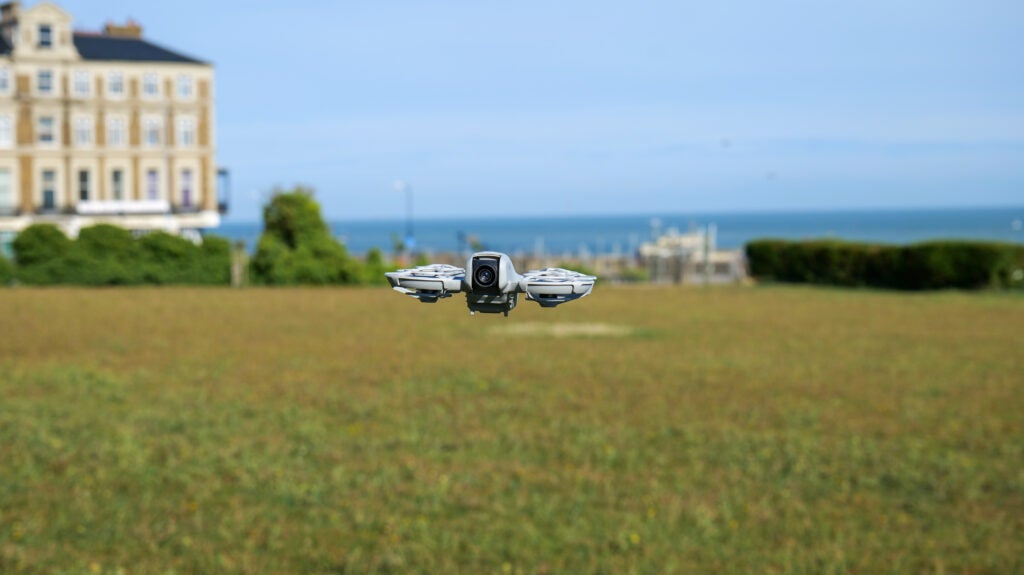

The drone doesn’t have obstacle avoidance, either. That’s not surprising, given the price, but it does somewhat limit its ability for automated flight indoors or in other confined spaces. It does seem designed with the supposition that it’ll crash sometimes, though: I managed to collide a couple of times with trees and bushes while reviewing it, and it didn’t suffer damage due to the well-protected props and general build quality.
It does have downward-facing sensors to aid take-off and landing, and this is the best drone I’ve ever used when it comes to launching and touching down into my hand. In most cases, you can just walk up to it, open your palm below it and it’ll lower itself onto it and cut the motors immediately.
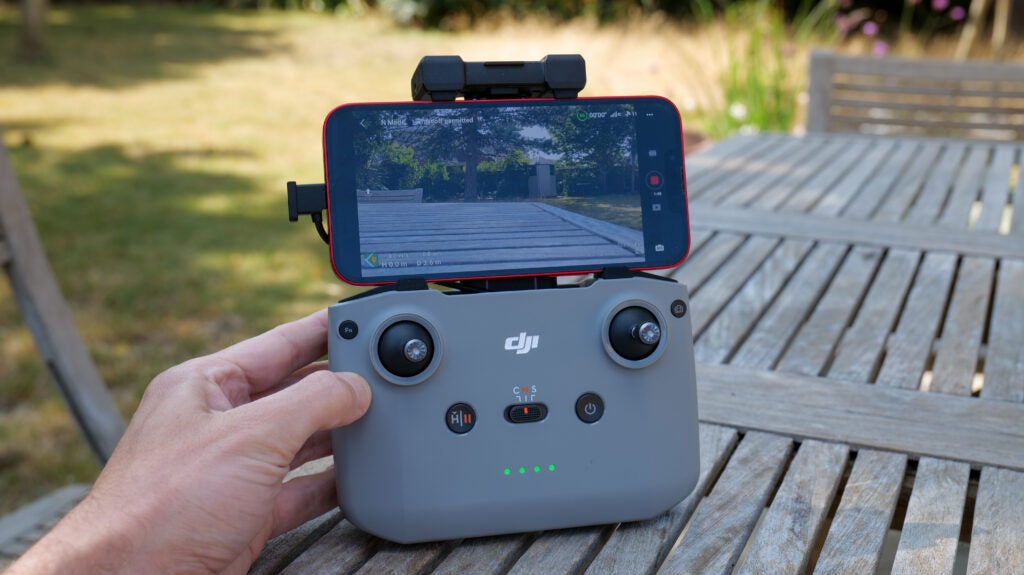

As a flyer, the Neo is pretty impressive, especially if you use the dedicated controller (you can even fly it as an FPV drone using DJI’s Goggles 3, but I wasn’t able to test this). It’s responsive, zippy and has a stable connection over a long range – up to 10km theoretically, although you’d be breaking the law if you fly it out of your eyesight range.
It feels like most other DJI drones when it comes to flight, although its low weight does mean it’s buffeted by wind a little more easily. As someone who lives on the always-breezy English coast, I found the drone struggled to remain stable at times. Even so, DJI claims it’s capable of remaining in place in winds up to ‘level 4’ or around 8m/s.
Without the controller, the Neo can be manually flown using a Wi-Fi-connected smartphone (with a range of about 30m) or using its built-in tracking system and the six Intelligent Shooting Modes, although the latter method is really only suitable for capturing short video clips of a few seconds.
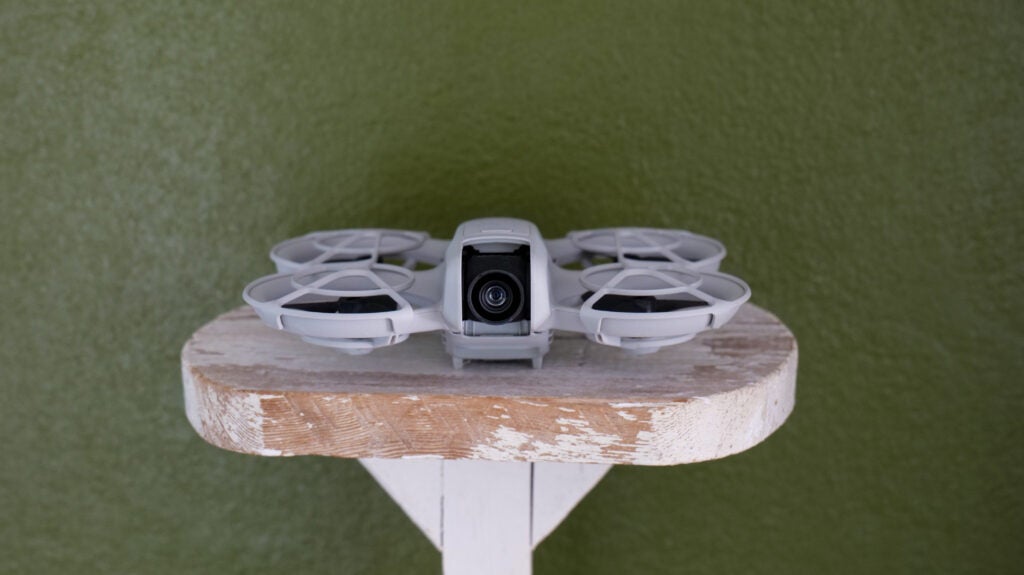

These modes keep the camera pointed at the user while the drone moves autonomously, either following the user as they move around or performing a pre-set series of movements. For instance, the ‘Dronie’ mode moves the Neo a few metres away, takes a video, and then moves it back so it can land in the user’s hand again. I found most of them a bit gimmicky, but the Follow and DirectionTrack modes, where the drone will move with the user as they walk, cycle, skate or similar, could be genuinely practical for vlogging purposes.
Unfortunately, I found the automated recordings had a habit of stopping before I wanted them to, leaving my clips annoyingly curtailed. It’s something that could perhaps be fixed with firmware updates but currently leave me wary of using the Neo for any sort of serious content creation purpose without a controller connected.
Camera Performance
- 4K or Full HD video recording
- Two image stabilisation modes
- 22GB of built-in storage
The camera on the Neo is serviceable rather than outstanding. Its half-inch sensor performs quite well in good lighting but I wasn’t particularly impressed with the sharpness or colour detail of the 4K/30p video it offers. It’s definitely good enough for making videos for TikTok, Reels or YouTube Shorts, but on a larger screen, its shortcomings become a lot more apparent.
Photos can only be captured in JPEG (not RAW) and there’s no D-Log option for videos, so they’re not suitable for much post-production tweaking. That’s in line with the Neo’s purpose as a fun, casual drone for capturing shots for instant sharing. You might make some basic edits on your phone, but you’re probably not importing the footage into Adobe Premiere for colour correction.
I don’t want to sound negative. This is, after all, a cheap drone, and comparing it to the superb performance of much pricier (if not much larger) models like the DJI Mini 4 Pro is doing it a disservice. There are impressive aspects, too. Despite not using a 3-axis gimbal, the footage is capably balanced through horizon-levelling electronic stabilisation, which corrects up to 45º in either direction. The drone also has access to ‘classic’ RockSteady stabilisation, but that’s something I’d only expect to use during FPV flight which, as I’ve already said, I wasn’t able to test during my review.
The 22GB of onboard storage allows for roughly 40 minutes of 4K footage or 55 minutes of Full HD footage, so I have no complaints about it at all. It’s also a fast and easy process to move footage and photos from the Neo to your phone via Wi-Fi thanks to the 30MB/s QuickTransfer connection, so if you do need to make more space it shouldn’t take long to free some up.
Latest deals
Should you buy it?
You want a fun, casual drone
The Neo is a zippy flier that’s adept at capturing quick, simple and decent-looking videos – even without a controller.
You want great image quality
The Neo’s image quality is acceptable rather than stellar, and a DJI Mini 3 or 4 drone represents a big step up in camera performance.
Final Thoughts
Despite its price and size, the Neo isn’t a toy drone. It’s not a serious drone for serious content creation either, but I do think it sits in a valuable hinterland between the two.
If you want to take aerial videos and photos and want a cheap device that can perform the task well, or if you want to learn the basics of drone flight, this thing hits the spot – and it’s markedly better designed than most of the similarly priced drones from other manufacturers I’ve reviewed in the recent past. If you want a higher-end model, there’s plenty of choice in our best drone list.
How we test
We thoroughly test every drone we review. We’ll always tell you what we find and we never, ever, accept money to review a product.
Looked at the flight safety features
Tested the camera quality
FAQs
The DJI Neo measures 157 x 130 x 48.5mm and weighs in at just 135g. This puts it well within the UK guidelines for sub-250g drones.
The Neo is priced at $199/£169 for the drone-only. However, DJI also offers a Fly More Combo which includes the drone, an RC-N3 controller, three Intelligent Flight Batteries and a Two-Way Charging Hub.
Jargon buster
USB-C
The modern USB connector you’ll find on most Android phones, new laptops, cameras and games consoles. It’s reversible and used for charging along with data-transfer.
mAh
An abbreviation for milliampere-hour and a way to express the capacity of batteries, especially smaller ones in phones. In most cases the higher the mAh, the longer the battery will last but this isn’t always the case.





